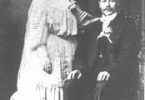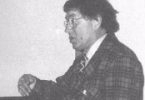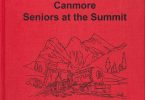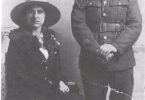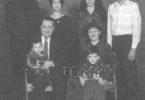Once upon a time, 100 years ago, Gian and Francesca Riva in Ribordone, Italy, packed their belongings, sons John and Joseph (four and one years of age), and emigrated to Canada. Perhaps I should say they emigrated to Canmore because, except for one trip back to Italy, they never ventured beyond Banff or Calgary. And why should they go further—Canmore was much like home in Ribordone; they were busy working and raising a family and were very happy.
In that same year, 1900, Gian started to work at the No. 1 mine for $2.10 per ten hour day, six days a week. He also developed a large vegetable garden, made wine with raisins and dandelions, and whatever wild berries were available. Francesca delivered two more boys, Victor and Michael, and a girl, Linda, who died at an early age. In her spare time, Francesca tended the chickens, fed a boarder and baked bread in a hillside oven.
Their home was built against the hill on a small flat just west of Southwood’s present home. Clearly built by amateurs, it nevertheless was the cradle for five continuous generations of Rivas in Canmore, the last of which, in our branch of the family, are Pat and Nancy’s children, Lana, Dale and Alan.
My father and mother, Joseph and Grace Riva, were married in 1921. Dad was the second Riva son. Mom was an orphan adopted in Calgary by watchmaker Erle Walker and wife, Mary, in 1905. Ten years later they moved and set up shop in Canmore.
Dad was a quiet man whose first love (besides my mother) was the automobile, followed closely by a remarkable loyalty to his work in the coal mine which was shared by his brothers who also spent virtually all of their working lives in and around the mine. In fact, so did many of their offspring; from 1900 when Gian started at No. 1 mine, through 1978 when all the mines closed, there was always at least one of the family on the payroll with jobs ranging from miners, mechanics, foremen, union secretary, surveyors, and Executive V.P. and C.E.O.
Mom was a bright and talented lady. She played the background piano music to provide atmosphere for silent movies in the Opera House. Unfortunately she developed a rheumatic heart. She became a pioneer recipient of a new heart valve in 1965. She lived for just two years after surgery. I once asked her if a hundred dollars was a lot of money. Her answer, I have often thought since, was indeed a wise one: “It depends a great deal on whether or not you have a hundred dollars !”
My most vivid memories of Canmore relate to two distinct periods: first, the school years (1928 to 1940), and second, the twenty-three years starting in 1949 following our return after war service and university.
Grades one to nine at school and all the associated activities were fun, so were hockey, hiking, skinny-dipping “behind doctor’s”, basketball, gym, summer camp at Beaufort, violin lessons and the Strauss/ Lytkowski junior symphony. What a wonderful, carefree life in this magnificent valley, and we (1000 people) had it all to ourselves!
But how could we be so happy? After all, we were, by almost any standard, poor. Most of our parents worked either directly or indirectly for the mining company, which during the ’30’s provided only two or three days work a week at $5.50 a day. Few families had annual incomes of more than $1000.00. Facilities and services were primitive: outdoor biffies were the order of the day for 90% of the community, telephones only for essential services and perhaps a dozen VIP private homes. Refrigerators were non-existent and ice boxes scarce. We did have root cellars! Electricity was expensive although many householders on the mine side devised a shunt around the meter!
However, even though a surprising number of families either owned or had access through friends to an automobile, children from grades one to twelve walked or biked to school, summer and winter; there was no such thing as a parking lot and no cars at school.
On the other hand, most of our daily needs and desires were cheap: the covered rink which had been built by the company was also maintained at no cost to the community except for the caretaker’s wages which were reflected in the cost of season tickets —children $2, adults $5; medical coverage was $2 per month per family; movies 15 cents for children, $1 for the whole family. The entire spectrum of nature-based amenities: hiking, mountain climbing, swimming in the rivers and lakes (brrrr!), berry picking, were, of course, free, as was the indescribable thrill of skating or sledding for miles on the Bow River.
By the late ’30’s, nothing had really changed in Canmore but now I was in high school with a great group of friends and teachers. Everything seemed better and there were odd jobs available for most of the boys such as bus boys at Banff Springs Hotel where pay was $26 a month plus board and room for nine plus hours a day, six days a week. It was here that I was told that Italians were good for two things —waiters and crooks!!
So we were very busy in high school with school work, school-related activities (operettas, plays, track meets), and extra-curricular fun such as hockey. We even discovered that the girls were getting more attractive every year! The icing was on the cake when I met Lorraine, the prettiest and brightest girl in town—she had just won the Governor General’s medal for scholarship. The rest is history!
And what a history it has turned out to be! Graduation from high school in 1940 meant moving into a world which would be at war for the next five years. So we did what seemed right each step along the way and surprisingly, it all worked out very nicely.
Lorraine and I were married in 1942 just before I entered the Air Force. When the war ended in late 1945, we headed to university in Edmonton on grants from DVA and with two toddlers, LeEllen and Pat. Our third child, Don, was born in 1946.
1949 was graduation year and while we were waiting anxiously for job offers, a letter came from The Canmore Mines Ltd. which said all the right things: “We have an opening for a mining engineer at $300.00 a month and a house that your family will fit into.” What in the world would we do with all that money!!
Thankfully, we moved back to Canmore, reminding ourselves that without the was our fortunes would have been quite different.
Although Canmore had prospered during the 40’s, it was still a small, (pop. 1200) one-industry town with no major changes in sight. But the residents for the most part were the same friendly, energetic community-minded people that we had grown up with. July 1st with the parade and races and ball game was still the most important summer holiday and the Union Christmas Tree saw that every child in town received a gift. So we stayed for a very happy, fulfilling twenty-three years, rounding out our family with Susan, Michael, and Raymond. It was a wonderful experience to raise our family in the same environment as we had known. We participated to the best of our ability in any and all local projects that could use our help. Happily our family still living in Canmore, Pat and Nancy, have continued the Tradition.
Since we left in 1973, Canmore has changed beyond all expectations and we look with much pride and some regrets at the startling developments that have changed the valley forever; congratulations are due to those responsible for the evolution, however, I would like to close this presentation with a story which I have recalled on most every visit to Canmore in recent years. In the ’60’s, a representative of a major California mining company asked Canmore Mines Ltd. if the company was available for purchase. The answer was, “Yes, if the price is right.” After examination of the property and facilities, the prospective buyer reported, with regrets, that the operation wasn’t quite what they were looking for.
He then said, “I’m sorry it worked out this way because this is one of the most beautiful valleys in the world, and someday, for any number of reasons, a lot of people and businesses will settle here, and as I say this to you, you are thinking, ‘wouldn’t that be great!’ Let my tell you that I have seen it happen many times in California, and when it does happen, I promise, you really won’t like it!”
Prophetic? Some of us old timers just might agree with him.
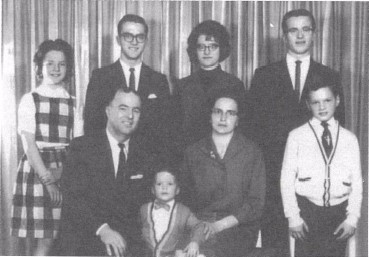
Walter Riva family 1964 l to r. back Susan, Don, LeEllen, Pat, front Walter, Lorraine, Raymond, Michael
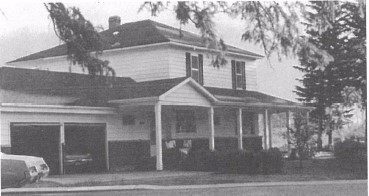
Walter Riva’s home in Canmore 1951-1972
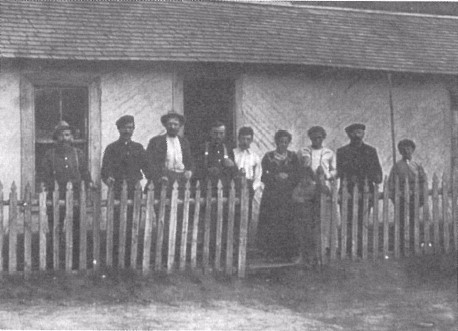
Riva home, family and friends about 1906
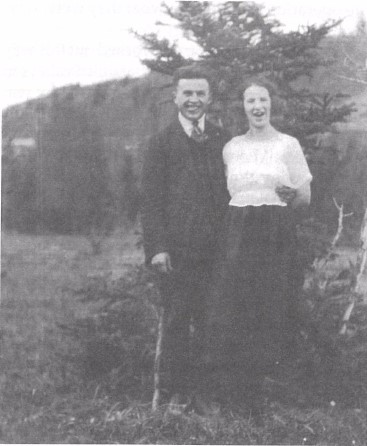
Joe and Grace Riva’s wedding, July 1921
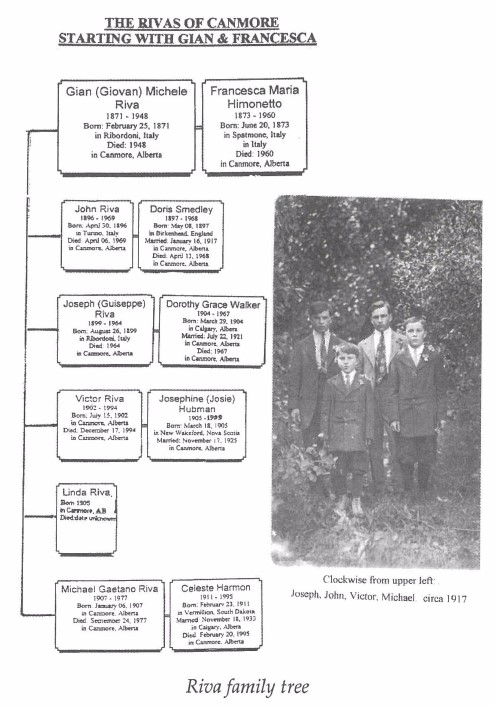
Riva family tree
In Canmore Seniors at the Summit, ed. Canmore Seniors Association, 2000, p. 243-246.

